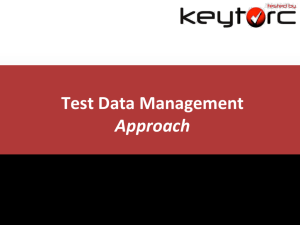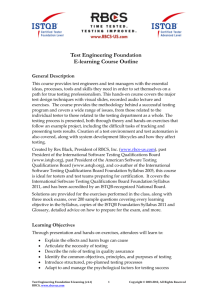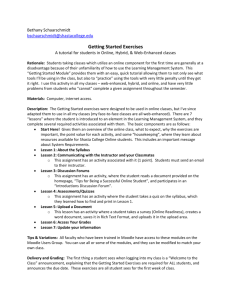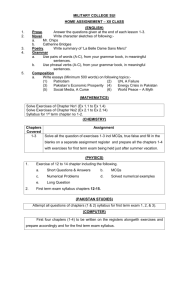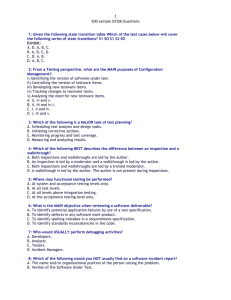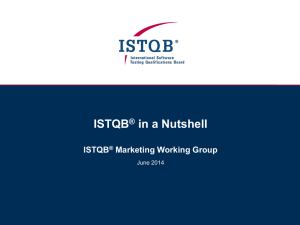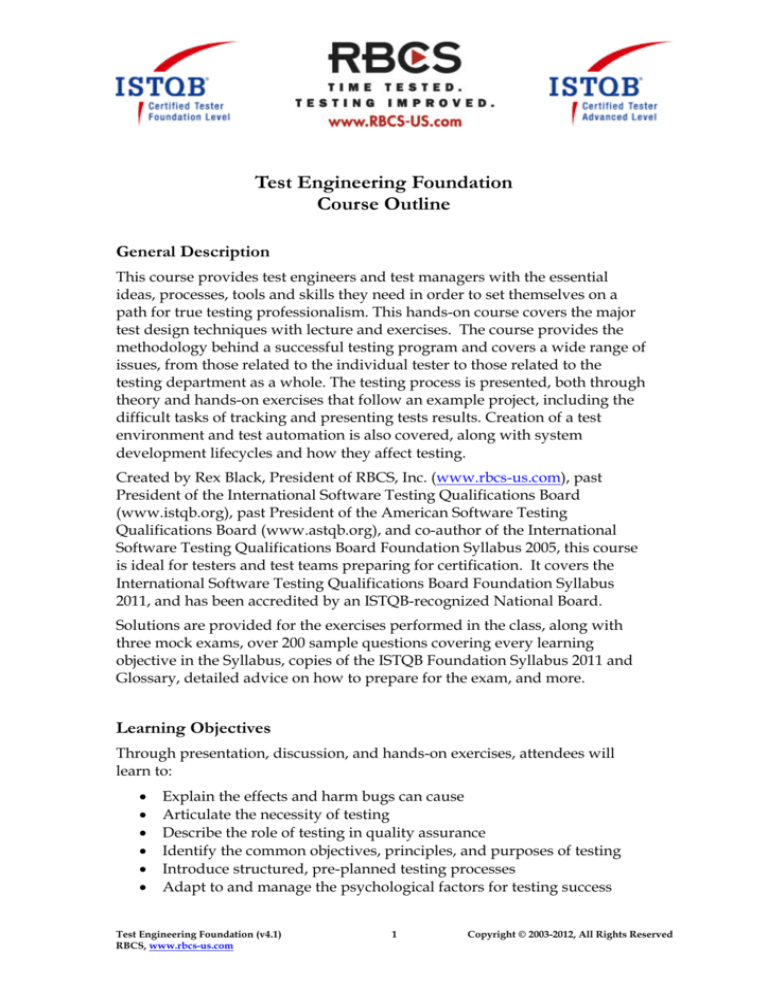
Test Engineering Foundation
Course Outline
General Description
This course provides test engineers and test managers with the essential
ideas, processes, tools and skills they need in order to set themselves on a
path for true testing professionalism. This hands-on course covers the major
test design techniques with lecture and exercises. The course provides the
methodology behind a successful testing program and covers a wide range of
issues, from those related to the individual tester to those related to the
testing department as a whole. The testing process is presented, both through
theory and hands-on exercises that follow an example project, including the
difficult tasks of tracking and presenting tests results. Creation of a test
environment and test automation is also covered, along with system
development lifecycles and how they affect testing.
Created by Rex Black, President of RBCS, Inc. (www.rbcs-us.com), past
President of the International Software Testing Qualifications Board
(www.istqb.org), past President of the American Software Testing
Qualifications Board (www.astqb.org), and co-author of the International
Software Testing Qualifications Board Foundation Syllabus 2005, this course
is ideal for testers and test teams preparing for certification. It covers the
International Software Testing Qualifications Board Foundation Syllabus
2011, and has been accredited by an ISTQB-recognized National Board.
Solutions are provided for the exercises performed in the class, along with
three mock exams, over 200 sample questions covering every learning
objective in the Syllabus, copies of the ISTQB Foundation Syllabus 2011 and
Glossary, detailed advice on how to prepare for the exam, and more.
Learning Objectives
Through presentation, discussion, and hands-on exercises, attendees will
learn to:
•
•
•
•
•
•
Explain the effects and harm bugs can cause
Articulate the necessity of testing
Describe the role of testing in quality assurance
Identify the common objectives, principles, and purposes of testing
Introduce structured, pre-planned testing processes
Adapt to and manage the psychological factors for testing success
Test Engineering Foundation (v4.1)
RBCS, www.rbcs-us.com
1
Copyright © 2003-2012, All Rights Reserved
Course Outline
•
•
•
•
•
•
•
•
•
•
•
•
•
•
•
•
•
•
•
•
•
•
Relate development and test activities
Adapt software development models to the context of the project and
product
Select and implement appropriate levels or phases of testing, with the
proper participants, objectives, targets, and items under test for each
test level or phase
Select and plan for major test types or targets, including functional and
non-functional tests, structural tests, confirmation tests, and regression
tests
Explain the reasons for maintenance testing and how maintenance
testing differs from new application testing
Understand the value, importance and use of static techniques and
static analysis, and the difference between static and dynamic
techniques
Explain the phases, roles and responsibilities of a typical formal
review, and contrast different types of reviews
Understand the factors for successful reviews
Understand and perform a quality risk analysis to serve as the basis for
testing, using the factors of likelihood and impact to determine the
level of risk
Write test designs, cases, and procedures, relate them to each other,
and trace these items to the test basis
Develop a test execution schedule
Explain the characteristics, differences, and reasons for specificationbased (black box), structure-based (white box), and experience-based
tests
Write test cases using equivalence partitioning, boundary value
analysis, decision tables, and state transition diagrams, understanding
the main purpose of each technique and what sufficiency of coverage is
for each technique
Write and measure test cases using structural testing concepts like
coverage, statement and decision coverage, and other control-flow test
design techniques
Understand the factors that influence the selection of appropriate test
design techniques
Explain the importance of independent testing
Understand the benefits and drawbacks of independent testing
Select different team members for inclusion in a test team
Know the tasks of typical test leader and tester
Understand and write various types of test plans depending on the
project, levels, and targets
Estimating testing via metrics and expertise, and recognize the factors
that affect an estimate
Understand, use and interpret common metrics to monitor test
preparation and execution
Test Engineering Foundation (v4.1)
RBCS, www.rbcs-us.com
2
Copyright © 2003-2012, All Rights Reserved
Course Outline
•
•
•
•
•
•
•
•
•
•
Explain how configuration management supports testing
Know typical hazards and potential risks for testing
Differentiate between project and quality (product) risks
Write a good bug or incident report, with the proper content
Know the different types of test tools, including programmers’ test
tools
Explain different scripting techniques for test execution tools,
including data driven and keyword driven
Know the potential benefits and risks of test automation
Plan to introduce a test tool into an organization
State the goals of a proof-of-concept for test tool evaluation
Explain the factors required for good tool support
Course Materials
This course includes the following materials:
Name
Description
Course Outline
A general description of the course along with learning
objectives, course materials and an outline of the course
topics, including approximate timings for each section.
Noteset
A set of over 500 PowerPoint slides covering the topics
to be addressed.
Text book
Foundations of Software Testing: ISTQB Certification an
essential guide to software testing and the ISTQB
Foundation qualification, authored by a group involved
in the writing of the ISTQB Syllabus.
Sample Exam
Questions
A complete set of questions for every learning objective
in the ISTQB Foundation Syllabus. Also three mock
exams are included to assess your readiness for the
ISTQB Foundation exam.
Project Source
Documents for
Course Exercises
Specifications used in the realistic example project used
in exercises for the course.
Exercise Solutions
A set of approximately 100 pages of detailed solutions
for all exercises in the course.
Six Study Guides
Chapter by chapter detailed notes on the slides for each
of the six chapters.
ISTQB Foundation
Syllabus
The Certified Tester Foundation Level Syllabus which
forms the basis for the International Software Testing
Qualification at the Foundation Level.
Test Engineering Foundation (v4.1)
RBCS, www.rbcs-us.com
3
Copyright © 2003-2012, All Rights Reserved
Course Outline
Name
Description
ISTQB Glossary
The latest glossary of terms used in Software Testing
produced by member of the ISTQB.
ISTQB Exam
Guidelines
Exam format and question writing guidelines.
Test Standards
A handy reference for standards used in testing.
Information for
those pursuing
Certification
Tips and advice on how to prepare for the exam.
Bibliography and
resources
A set of further readings, Web sites, tools and other
resources to help implement the concepts.
The printed course materials are provided in a binder in a way which makes
it convenient for course attendees to remove portions as needed for reference;
e.g., during exercises.
Session Plan
The course runs for four days, with two hours set aside on the fourth day for
the ISTQB Foundation exam if desired. Each day is about 360 minutes of class
time, from 9:00 to 5:00. For accredited course offerings, material is covered as
described. For custom courses, material may be deleted, added, or expanded
upon as needed.
Please note that timings are approximate, depending on attendee interest and
discussion. All of the lectures include exercises except as noted.
1.0
1.1
1.2
1.3
1.4
1.5
1.6
Introduction (20 minutes, no exercise)
Fundamentals of testing
Why is testing necessary (25 minutes, no exercise)
What is testing (30 minutes)
General testing principles (45 minutes)
Fundamental test process (40 minute)
Psychology of testing (40 minutes)
Code of Ethics (10 minutes, no exercises)
2.0
2.1
2.2
2.3
2.4
Testing throughout the software life cycle
Software development models (30 minutes)
Test levels (60 minutes)
Test types (60 minutes)
Maintenance testing (30 minutes)
3.0
3.1
3.2
3.3
Static techniques
Static Techniques and the test process (25 minutes)
Review process (45 minutes)
Static analysis by tools (30 minutes)
Test Engineering Foundation (v4.1)
RBCS, www.rbcs-us.com
4
Copyright © 2003-2012, All Rights Reserved
Course Outline
4.0
4.1
4.2
4.3
4.4
4.5
4.6
Test Design Techniques
Test Development Process (90 minutes)
Categories of test design techniques (25 minutes)
Specification-based or black-box techniques (150 minutes)
Structure-based or white-box techniques (60 minutes)
Experience-based techniques (30 minutes)
Choosing test techniques (25 minutes)
5.0
5.1
5.2
5.3
5.4
5.5
5.6
Test management
Test organization (40 minutes)
Test planning and estimation (70 minutes)
Test progress monitoring and control (50 minutes)
Configuration management (30 minutes)
Risk and testing (30 minutes)
Incident management (65 minutes)
6.0
6.1
6.2
6.3
Tool support for testing
Types of test tools (70 minutes)
Effective use of tools: potential benefits and risks (35 minutes)
Introducing a tool into an organization (25 minutes)
Question and answer period (15 minutes, no exercise)
Appendix A: For Those Pursuing Certification
Appendix B: ISTQB Foundation Level Syllabus
Appendix C: List of Applicable Standards
Appendix D: ISTQB Glossary of Testing Terms
Appendix D: OmniNet Marketing Requirements Document
Appendix F: OmniNet System Requirements Document
Recommended Readings
The class materials include an extensive bibliography of books related to
software testing, project management, quality, and other topics of interest to
the test professional.
Test Engineering Foundation (v4.1)
RBCS, www.rbcs-us.com
5
Copyright © 2003-2012, All Rights Reserved

